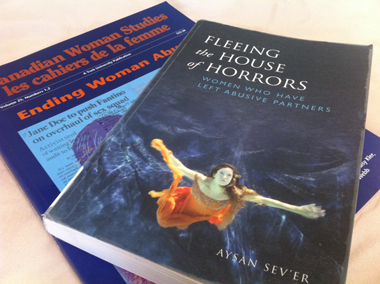 Can you say that statistics have changed your life? Maybe even saved it? Probably not.
Can you say that statistics have changed your life? Maybe even saved it? Probably not.
But when I took WMST 422 (the precursor to WGST 422, subject of a recent Course Exam article in The Voice), the most important thing I learned wasn’t the global prevalence of violence against women. It wasn’t the responses of global community and UN to violence against women. And it wasn’t the systemic and institutional power structures that allow violence against women to continue. It was the simple, straightforward statistics about violence against women in Canada.
These statistics weren’t just about the overall occurrence of violence, but also about when and where certain women experienced abuse?including rates of abuse by age, income, and geographic location. For example, did you know that, according to Statistics Canada, those aged 15-24 are most likely to be victimized, followed by those 25-34, and the risk continues to decrease with age? The same groups are also more likely to be victims of spousal homicide. And consistently, about 70% of those in abusive situations say they have told someone within the last year.
Statistics helped me make sense of my experiences. They explained that abuse often increases with life changes, like beginning a new job or schooling (as I did) or becoming pregnant (as I did). They predicted that abusers often try to isolate women from their families and friends, frequently by moving long distances (as we did), or controlling access to transportation and communication devices (remember how I mentioned Brent’s problem with phones?).
Eventually, I reached a point where I knew that there was nothing I could ever do that would make things good enough for Brent to be happy. I knew that no amount of housekeeping or healthy cooking or changing my behaviour to fit into Brent’s mold would ever fix his anger management problems. Sadly, it took years to get to that point, and multiple failed escape attempts before I was successful. In the end, I knew that actually getting out for good would require money, a careful plan, and both personal and physical strength.
And then statistics helped me to stay safe and prepare myself for possibilities that I had once never imagined. Things like the potential that even once I got away from Brent, he could still be dangerous.
The Canadian Women’s Foundation, in their Facts About Violence Against Women, notes that “about half (49%) of all female murder victims in Canada are killed by a former or current intimate partner.” And violence often escalates after separation: Statistics Canada reports that “in 2009, 17% of Canadians who had contact with an ex-spouse or partner? had been physically or sexually assaulted,” and further, that “female victims of spousal homicide were more likely than male victims to be killed by a partner from whom they were separated.” In Fleeing the House of Horrors, Aysan Se?ver notes that married women are nine times more likely to be killed by their partner than by a stranger, and after separation, even though husbands have less access to their estranged wives, this risk increases six times.
Because I had learned about these statistics, I took several precautions when and after I left. And I was lucky: though there were some threats and indications of stalking, and one incident where Brent became physical, eventually these petered out.
Part of what continues to disturb me, though, is that in all the years that we were together, there were many times when people had had the opportunity to intervene?to help me escape the hell?and didn’t. Along the way, there were times when people could have stepped in and offered to assist, and it always hurt to wonder why some people had passed up these chances.
Once, for example, Brent answered the door to find a police officer who asked to speak to me. When I came into the living room, the male officer announced, in front of Brent, that my friend Kari was worried about my safety and thought that I was in danger. I had no idea how to respond. The officer looked back and forth from me to Brent, and then said “you don’t look like You’re in any immediate danger. Is there a chance that your friend might have exaggerated things a little?” And then he rolled his eyes, turned, walked out, and left. Guess how well that went over with Brent?
And many months later, there was one day when I was terrified of what Brent would do, and for the first time, I called the police myself. It took them more than half an hour to arrive, and when they did, the female officer advised me that I had the right to press charges about Brent, but that based on the fact that she couldn’t see “any real injuries,” and couldn’t be sure “what had really happened,” it was highly unlikely that any judge would believe there had been abuse. When I asked her about an emergency protection order, she told me that I would have go to court and talk to a judge about it. After that, I never bothered to call the police. What good would it do?
But it wasn’t only the police who turned a blind eye to our situation. Throughout our time together, there were times we lived in apartments with paper-thin walls, and neighbours could easily have stopped by when Brent was out to ask if I was okay or ask how it was going. There were many times when we were out in public that Brent would scream and throw things at me, and strangers would walk by, trying not to look at us. And there were people in his family who were there when he would give me strict orders and physically push me around.
I know that jumping into the middle of a potentially violent situation might not be the best way to help, but neither is turning a blind eye and trying to walk by as if nothing is going on. Family violence, violence against women?it isn’t a private or personal matter. It’s bad for women, It’s bad for their friends and families, and It’s bad for our society as a whole (in fact, if you think in monetary terms, spousal violence in Canada comes with an estimated price tag of 7.4 billion dollars per year).
There are hundreds of reasons why some women choose to stay, and the Ray Rice / Janay Palmer incident that happened about a year ago saw many abuse survivors taking to Twitter to share their stories with the hashtag #whyIstayed. Based on my experience, the most important thing that women in abusive situations need to hear is that people will believe their stories and be willing to help. Just believe them, be there to help if needed, and be patient with them (even when you can’t understand why they’re staying) until they’re at a point they’re ready and able to leave.
Years later, I can say that I feel safe and happy. But the many years I spent living in hell I will never get back, and they continue to create challenging repercussions. On the whole, though, I’m incredibly lucky: I have a wonderful life in the world after violence against women.
If learning more about violence against women just isn’t a top personal priority for you, That’s okay. We don’t all have the same interests or inclinations. But I’d also suggest that this is perhaps the best reason why you should consider taking WGST 422. It might not be directly applicable to your future education or employment plans, but if you have the ability to take it, I can think of no other course I would more highly recommend.
According to the Canadian Women’s Foundation, a full half of women in this country have experienced physical or sexual violence at least once. Half. Every second woman in Canada. Maybe your learning, your knowledge, your belief, or your support could be what helps one of your friends or family members to escape.

